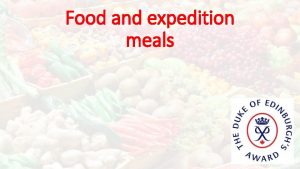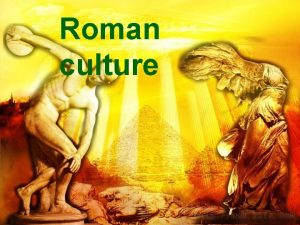Roman meals A Typical Romans Food for the








- Slides: 8

Roman meals A Typical Roman's Food for the day: ieutaculum - This would be eaten early, probably as soon as the sun rose and would include bread and fresh fruit. prandium - Probably taken around noon. Lunch was only a small meal as it was thought a large meal would make one fall asleep in the afternoon. It would include some of the following - a little cooked meat - ham or salami, salad, cheese, hard-boiled eggs, vegetables and bread. cena - This would begin at about four in the afternoon and could continue into the night. The starter would be either a salad or dish of small fish. The main course of fish, cooked meat and vegetables would be served next. The dessert would consist of fresh fruit and cheese. Sometimes small cakes sweetened with honey would be served.

Dining - Triclinium • Triclinium – room for 3 dining couches with 3 places for reclining (Only children, slaves, rubes ate sitting up!) • 3 couches arranged around a square table • Nomenclator – usher announced guests • Full Dress Cena is 7 courses hor d’oeuvres – gustatio 3 entrées 2 roasts dessert – secunda mensa • Commissatio – drinking period, governed by a rex bibendi • Vomitorium – area for ridding oneself of burden in order to continue feasting


The order of reclining at table encapsulated world-building. The guests' positions carried such inherent connotations of social differentiation that not even a meal of amici was necessarily free of social gamesmanship. The guest of honor (locus consularis) traditionally had the choice location at table, with proximity and primary access to the host. All other guests were placed at the discretion of the host, usually according to their rank and status from the lectus summus on down. Members of the host's familia, such as his wife or freedpersons, would lie on his couch (lectus imus) in the places of lowest status (if they were present at the meal). Slaves were not normally allowed to recline at dinner or eat during dinner because they were busy cooking and serving the meal, and were not of adequate rank to join the company regardless. -Pedar W. Foss, "Kitchens and Dining Rooms at Pompeii

Vagarities of human taste Marco Polo – Chinese eat dogs, cats, rats, and mole soup; Tartars eat rats, horse, dog ROMANS! • Mixed sweet and sour (vinegar with honey & mint) • Drank wine hot (mulled wine with honey) • Used lots of sauces, esp. fish sauce

Liquamen Fish guts and chopped fish pounded and stirred to thick fluid, left in sun to ferment until most moisture evaporates, strained through basket Light fluid – garum Mush remaining – allec Martial – 2 eggs plus dash of garum for a good breakfast Garum production was a major industry in and out of Rome.

Other foodstuffs • Botulus – sausage. Ingredients stuffed into pig’s bladder • Puls – boiled wheat or barley • Fructus – varieties of local fruits/veggies apples and pears and figs and plums (and prunes, which are dried plums) and raisins (made from the grapes), green peas (mostly dried like for split-pea soup), lentils, and chickpeas onions, carrots, garlic, and cabbages honey (they didn't have sugar) herbs like dill, thyme, oregano, basil, and mint nuts, especially walnuts and chestnuts and acorns cucumbers (they didn't have tomatoes)

Livestock eggs (from chickens and from geese and ducks) yogurt and cheese, mostly from goats and sheep mutton (sheep meat), goat meat, and pork and ham and bacon, chicken, goose and duck, and fish, especially tuna. Oh, and snails - people raised them in special snail gardens, with little box hedges for them to crawl on.















